实验3:OpenFlow协议分析实践
实验3:OpenFlow协议分析实践
一、实验目的
-
1.能够运用 wireshark 对 OpenFlow 协议数据交互过程进行抓包;
-
2.能够借助包解析工具,分析与解释 OpenFlow协议的数据包交互过程与机制。
二、实验环境
-
1.下载虚拟机软件Oracle VisualBox;
-
2.在虚拟机中安装Ubuntu 20.04 Desktop amd64,并完整安装Mininet;
三、实验要求
(一)基本要求
1.搭建下图所示拓扑,完成相关 IP 配置,并实现主机与主机之间的 IP 通信。用抓包软件获取控制器与交换机之间的通信数据包。

| 主机 | IP地址 |
|---|---|
| h1 | 192.168.0.101/24 |
| h2 | 192.168.0.102/24 |
| h3 | 192.168.0.103/24 |
| h4 | 192.168.0.104/24 |
-
在终端输入sudo ./../mininet/examples/miniedit.py搭建拓扑
-
配置网段

-
配置IP地址

-
保存py文件到lab3
-
测试连通性

2.查看抓包结果,分析OpenFlow协议中交换机与控制器的消息交互过程,画出相关交互图或流程图。
(1)Hello
-
控制器6633端口(我最高能支持OpenFlow 1.0) ---> 交换机48528端口
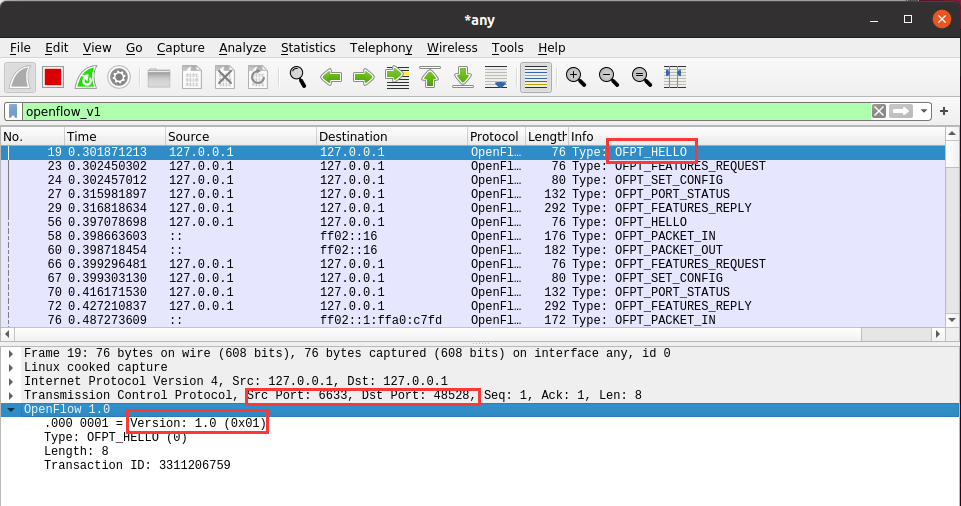
-
交换机48528端口(我最高能支持OpenFlow 1.3)--- 控制器6633端口
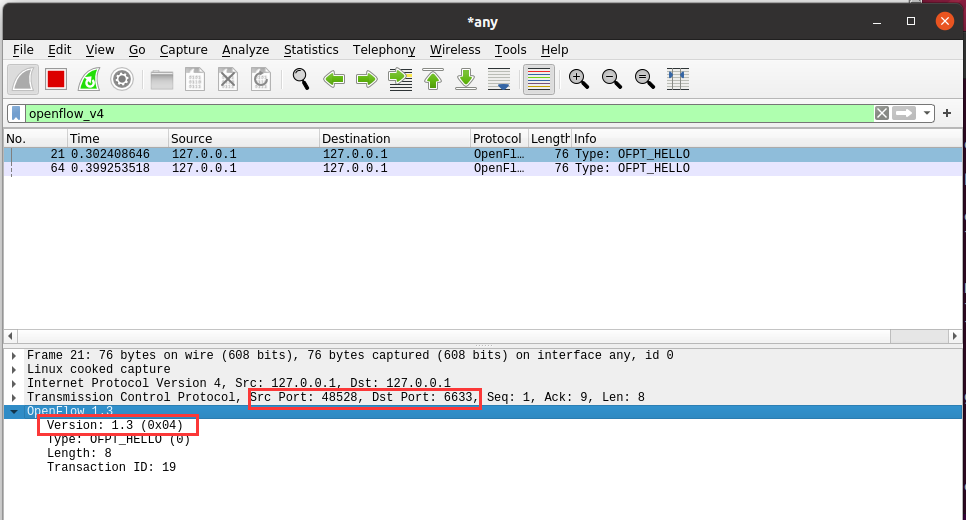
- 于是双方建立连接,并使用OpenFlow 1.0
(2)Features Request / Set Conig
-
控制器6633端口(我需要你的特征信息) ---> 交换机48528端口

-
控制器6633端口(请按照我给你的flag和max bytes of packet进行配置) ---> 交换机48528端口
- flag:指示交换机如何处理 IP 分片数据包
- max bytes of packet:当交换机无法处理到达的数据包时,向控制器发送如何处理的最大字节数,本实验中控制器发送的值是0x0080,即128字节。
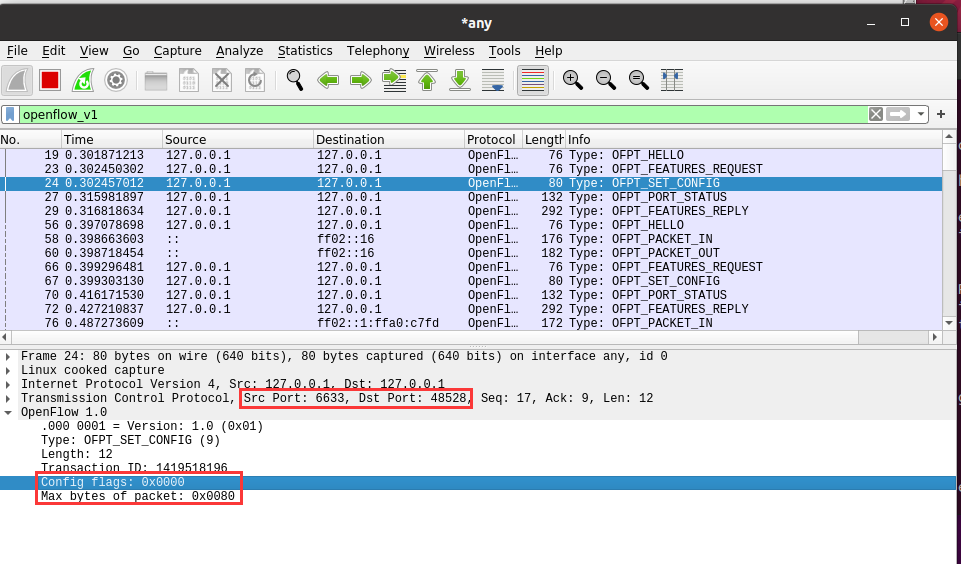
(3)Port_Status
- 当交换机端口发生变化时,告知控制器相应的端口状态。
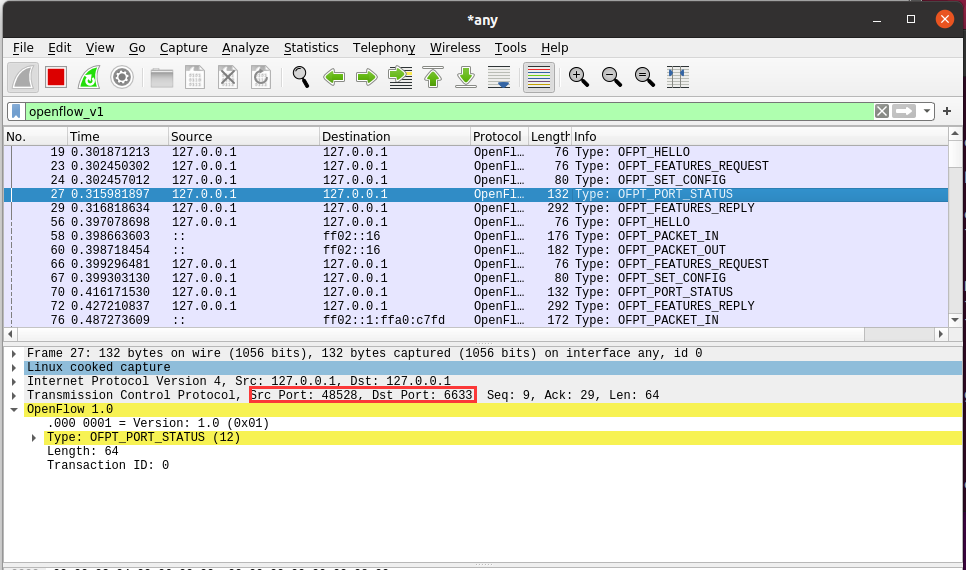
(4)Features Reply
- 交换机48528端口(这是我的特征信息,请查收)--- 控制器6633端口

(5)Packet_in
- 有两种情况:
- 交换机查找流表,发现没有匹配条目时
- 有匹配条目但是对应的action是OUTPUT=CONTROLLER时
- 交换机48528端口(有数据包进来,请指示)--- 控制器6633端口

- 分析抓取的数据包,可以发现是因为交换机发现此时自己并没有匹配的流表(Reason: No matching flow (table-miss flow entry) (0)),所以要问控制器如何处理
(6)Flow_mod
- 分析抓取的flow_mod数据包,控制器通过6633端口向交换机48528端口、交换机48530端口下发流表项,指导数据的转发处理

- 分析抓取的flow_mod数据包,控制器通过6633端口向交换机48528端口、交换机48530端口下发流表项,指导数据的转发处理

(7)Packet_out
- 控制器6633端口(请按照我给你的action进行处理) ---> 交换机48528端口

(8)交互图

3.回答问题:交换机与控制器建立通信时是使用TCP协议还是UDP协议?

使用了TCP协议,抓包截图与0031902627.py源码中均能体现

(二)进阶要求
1.将抓包结果对照OpenFlow源码,了解OpenFlow主要消息类型对应的数据结构定义。
(1)Hello

- 对应
struct ofp_header {
uint8_t version; /* OFP_VERSION. */
uint8_t type; /* One of the OFPT_ constants. */
uint16_t length; /* Length including this ofp_header. */
uint32_t xid; /* Transaction id associated with this packet.
Replies use the same id as was in the request
to facilitate pairing. */
};
OFP_ASSERT(sizeof(struct ofp_header) == 8);
/* OFPT_HELLO. This message has an empty body, but implementations must
* ignore any data included in the body, to allow for future extensions. */
struct ofp_hello {
struct ofp_header header;
};
(2)Features Request
- 与Hello中的数据格式相同

(3)Set Conig

- 对应源代码
struct ofp_switch_config {
struct ofp_header header;
uint16_t flags; /* OFPC_* flags. */
uint16_t miss_send_len; /* Max bytes of new flow that datapath should
send to the controller. */
};
OFP_ASSERT(sizeof(struct ofp_switch_config) == 12);
(4)Port_Status
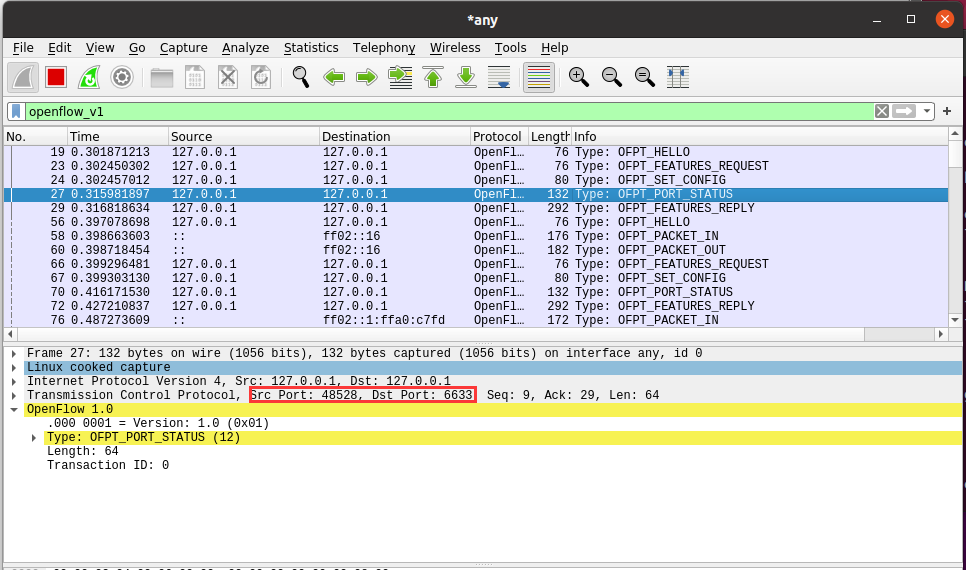
- 对应源代码
struct ofp_port_status {
struct ofp_header header;
uint8_t reason; /* One of OFPPR_*. */
uint8_t pad[7]; /* Align to 64-bits. */
struct ofp_phy_port desc;
};
OFP_ASSERT(sizeof(struct ofp_port_status) == 64);
(5)Features Reply

- 对应源代码
/* Description of a physical port */
struct ofp_phy_port {
uint16_t port_no;
uint8_t hw_addr[OFP_ETH_ALEN];
char name[OFP_MAX_PORT_NAME_LEN]; /* Null-terminated */
uint32_t config; /* Bitmap of OFPPC_* flags. */
uint32_t state; /* Bitmap of OFPPS_* flags. */
/* Bitmaps of OFPPF_* that describe features. All bits zeroed if
* unsupported or unavailable. */
uint32_t curr; /* Current features. */
uint32_t advertised; /* Features being advertised by the port. */
uint32_t supported; /* Features supported by the port. */
uint32_t peer; /* Features advertised by peer. */
};
/* Switch features. */
struct ofp_switch_features {
struct ofp_header header;
uint64_t datapath_id; /* Datapath unique ID. The lower 48-bits are for
a MAC address, while the upper 16-bits are
implementer-defined. */
uint32_t n_buffers; /* Max packets buffered at once. */
uint8_t n_tables; /* Number of tables supported by datapath. */
uint8_t pad[3]; /* Align to 64-bits. */
/* Features. */
uint32_t capabilities; /* Bitmap of support "ofp_capabilities". */
uint32_t actions; /* Bitmap of supported "ofp_action_type"s. */
/* Port info.*/
struct ofp_phy_port ports[0]; /* Port definitions. The number of ports
is inferred from the length field in
the header. */
};
(6)Packet_in

- 对应源代码
/* Why is this packet being sent to the controller? */
enum ofp_packet_in_reason {
OFPR_NO_MATCH, /* No matching flow. */
OFPR_ACTION /* Action explicitly output to controller. */
};
/* Packet received on port (datapath -> controller). */
struct ofp_packet_in {
struct ofp_header header;
uint32_t buffer_id; /* ID assigned by datapath. */
uint16_t total_len; /* Full length of frame. */
uint16_t in_port; /* Port on which frame was received. */
uint8_t reason; /* Reason packet is being sent (one of OFPR_*) */
uint8_t pad;
uint8_t data[0]; /* Ethernet frame, halfway through 32-bit word,
so the IP header is 32-bit aligned. The
amount of data is inferred from the length
field in the header. Because of padding,
offsetof(struct ofp_packet_in, data) ==
sizeof(struct ofp_packet_in) - 2. */
};
(7)Flow_mod

- 对应源代码
/* Fields to match against flows */
struct ofp_match {
uint32_t wildcards; /* Wildcard fields. */
uint16_t in_port; /* Input switch port. */
uint8_t dl_src[OFP_ETH_ALEN]; /* Ethernet source address. */
uint8_t dl_dst[OFP_ETH_ALEN]; /* Ethernet destination address. */
uint16_t dl_vlan; /* Input VLAN id. */
uint8_t dl_vlan_pcp; /* Input VLAN priority. */
uint8_t pad1[1]; /* Align to 64-bits */
uint16_t dl_type; /* Ethernet frame type. */
uint8_t nw_tos; /* IP ToS (actually DSCP field, 6 bits). */
uint8_t nw_proto; /* IP protocol or lower 8 bits of
* ARP opcode. */
uint8_t pad2[2]; /* Align to 64-bits */
uint32_t nw_src; /* IP source address. */
uint32_t nw_dst; /* IP destination address. */
uint16_t tp_src; /* TCP/UDP source port. */
uint16_t tp_dst; /* TCP/UDP destination port. */
};
/* Flow setup and teardown (controller -> datapath). */
struct ofp_flow_mod {
struct ofp_header header;
struct ofp_match match; /* Fields to match */
uint64_t cookie; /* Opaque controller-issued identifier. */
/* Flow actions. */
uint16_t command; /* One of OFPFC_*. */
uint16_t idle_timeout; /* Idle time before discarding (seconds). */
uint16_t hard_timeout; /* Max time before discarding (seconds). */
uint16_t priority; /* Priority level of flow entry. */
uint32_t buffer_id; /* Buffered packet to apply to (or -1).
Not meaningful for OFPFC_DELETE*. */
uint16_t out_port; /* For OFPFC_DELETE* commands, require
matching entries to include this as an
output port. A value of OFPP_NONE
indicates no restriction. */
uint16_t flags; /* One of OFPFF_*. */
struct ofp_action_header actions[0]; /* The action length is inferred
from the length field in the
header. */
};
(8)Packet_out

- 对应源代码
/* Action header that is common to all actions. The length includes the
* header and any padding used to make the action 64-bit aligned.
* NB: The length of an action *must* always be a multiple of eight. */
struct ofp_action_header {
uint16_t type; /* One of OFPAT_*. */
uint16_t len; /* Length of action, including this
header. This is the length of action,
including any padding to make it
64-bit aligned. */
uint8_t pad[4];
};
OFP_ASSERT(sizeof(struct ofp_action_header) == 8);
/* Send packet (controller -> datapath). */
struct ofp_packet_out {
struct ofp_header header;
uint32_t buffer_id; /* ID assigned by datapath (-1 if none). */
uint16_t in_port; /* Packet's input port (OFPP_NONE if none). */
uint16_t actions_len; /* Size of action array in bytes. */
struct ofp_action_header actions[0]; /* Actions. */
/* uint8_t data[0]; */ /* Packet data. The length is inferred
from the length field in the header.
(Only meaningful if buffer_id == -1.) */
};
四、个人总结
-
实验难度:适中
-
实验过程遇到的困难及解决办法:
- 在进行基本要求中的查看抓包结果,分析OpenFlow协议中交换机与控制器的消息交互过程时,忘了先开启抓包再运行拓扑,弄好后发现根本找不到flow_mod信号,于是发现要先ping一下主机,才能看到flow_mod。
- 刚开始找不到交换机对控制器发送的Hello信号,后来发现它支持最高的版本为OpenFlow 1.5,于是要用openflow_v6来过滤。
- 在完成进阶要求的时候,1000行的源码看的真的很辛苦,找的很累,后来就直接把源码复制到word,用word的查找功能,效率就快了很多!
- 打开抓包工具进入any后,没有hello的包,只看到的requst和reply的包,找了很久,重新打开也没用,后面发现需要先打开抓包工具,再打开mininet,不然会丢失前面的包。这次试验让我更加熟悉了拓扑构建工具和wireshark抓包工具的使用。
-
个人感想:
- 能够熟练运用 wireshark 对 OpenFlow 协议数据交互过程进行抓包。
- 学会借助包解析工具,分析与解释 OpenFlow协议的数据包交互过程与机制。
- OpenFlow的源码看的真累,有的还是看不懂,但看代码的话能确实能更加直观的理解OpenFlow协议。


